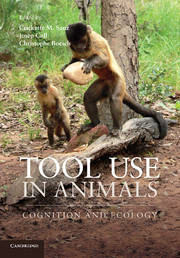Book contents
- Frontmatter
- Contents
- List of contributors
- Part I Cognition of tool use
- Part II Comparative cognition
- 4 Insight, imagination and invention: Tool understanding in a non-tool-using corvid
- 5 Why is tool use rare in animals?
- 6 Understanding differences in the way human and non-human primates represent tools: The role of teleological-intentional information
- 7 Why do woodpecker finches use tools?
- Part III Ecology and culture
- Part IV Archaeological perspectives
- Index
- References
7 - Why do woodpecker finches use tools?
from Part II - Comparative cognition
Published online by Cambridge University Press: 05 March 2013
- Frontmatter
- Contents
- List of contributors
- Part I Cognition of tool use
- Part II Comparative cognition
- 4 Insight, imagination and invention: Tool understanding in a non-tool-using corvid
- 5 Why is tool use rare in animals?
- 6 Understanding differences in the way human and non-human primates represent tools: The role of teleological-intentional information
- 7 Why do woodpecker finches use tools?
- Part III Ecology and culture
- Part IV Archaeological perspectives
- Index
- References
Summary
Introduction
Niko Tinbergen (1963) proposed four levels of analysis in seeking to explain why a given behavior exists: phylogenetic, functional, developmental and mechanistic. He postulated that only the integration of all four levels enables us to fully understand behavior. Animal tool use initially captivated the scientific world because of its resemblance to our own behavior, creating the impression that the origin of our own physical intelligence could be found in our close – and perhaps even distant – animal relatives. For a long time research on animal tool use has focused on the mechanistic and the ontogenetic level. The main question fueling this research was whether the cognitive abilities of humans and animals are on a continuum or whether one or several qualitative delimiting differences exist. Probably for this reason, most research has focused on primates and specifically on apes, our closest relatives. The anthropocentric approach has been helpful in drawing attention to the phenomenon of animal tool use. However, the empirical research on the cognitive abilities underlying this ability has revealed that even chimpanzees (Pan troglodytes), our closest relatives, do not possess a human-like understanding of the physical regularities governing tool use (Povinelli, 2000; Penn & Povinelli, 2007). A major contribution that this line of research has made to the field of comparative cognition is the growing awareness that a dichotomous distinction between high- and low-level processes may not be fruitful (Chappell, 2006). To date, the performance of New Caledonian crows (Corvus moneduloides) and chimpanzees in various tasks testing physical cognition indicates that their appreciation of these problems lies somewhere between a high-level understanding of the physical principles and low-level appreciation based on associative learning (Tomasello & Call, 1997; Bluff et al., 2007; Emery & Clayton, 2009; Taylor et al., 2009).
- Type
- Chapter
- Information
- Tool Use in AnimalsCognition and Ecology, pp. 134 - 158Publisher: Cambridge University PressPrint publication year: 2013
References
- 8
- Cited by

